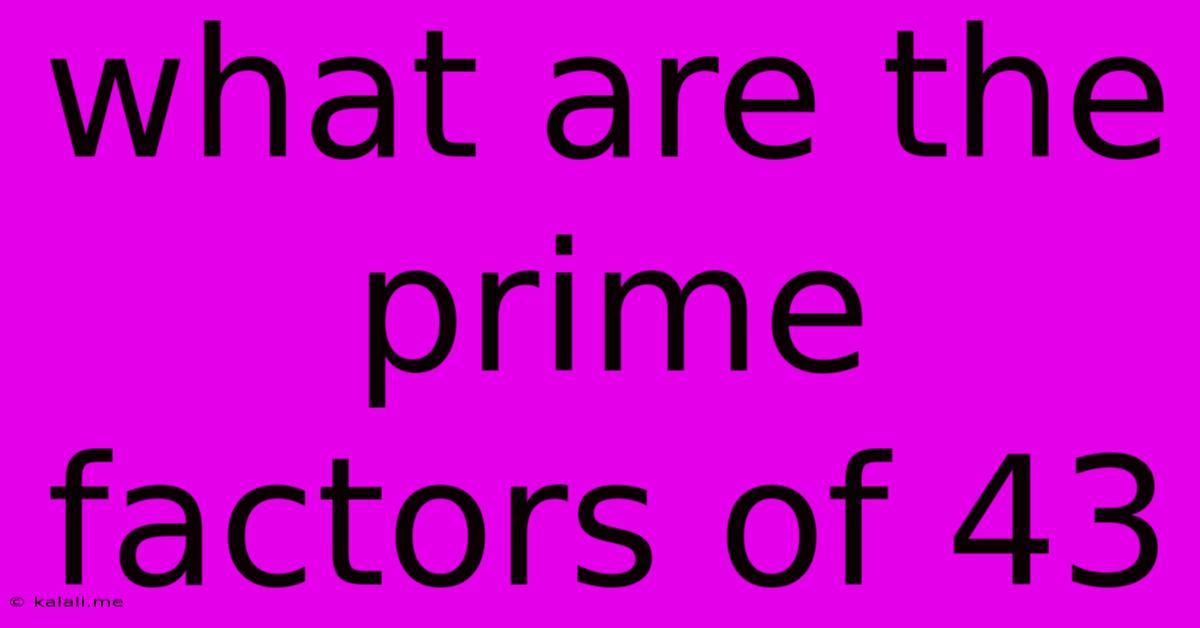What Are The Prime Factors Of 43
Kalali
Jun 14, 2025 · 2 min read

Table of Contents
What are the Prime Factors of 43? A Simple Explanation
Meta Description: Learn how to find the prime factors of 43. This guide provides a clear and concise explanation, perfect for students and anyone curious about prime numbers and factorization. We'll break down the process step-by-step, making it easy to understand.
Finding the prime factors of a number is a fundamental concept in number theory. It involves breaking down a number into its smallest building blocks – prime numbers. Prime numbers are whole numbers greater than 1 that are only divisible by 1 and themselves. Let's explore how to determine the prime factors of 43.
Understanding Prime Numbers
Before we delve into factoring 43, let's refresh our understanding of prime numbers. Some examples of prime numbers include 2, 3, 5, 7, 11, and 13. Notice that each of these numbers is only divisible by 1 and itself. Numbers like 4 (divisible by 2), 6 (divisible by 2 and 3), and 9 (divisible by 3) are not prime numbers; they are composite numbers.
Factoring 43: A Step-by-Step Approach
Now, let's tackle the prime factorization of 43. The process is straightforward for this particular number:
-
Check for Divisibility by Small Prime Numbers: We begin by checking if 43 is divisible by the smallest prime numbers: 2, 3, 5, 7, etc.
-
Is 43 Divisible by 2? No, 43 is an odd number, so it's not divisible by 2.
-
Is 43 Divisible by 3? The sum of the digits of 43 (4 + 3 = 7) is not divisible by 3, therefore 43 is not divisible by 3.
-
Is 43 Divisible by 5? Numbers divisible by 5 end in 0 or 5. 43 does not end in 0 or 5.
-
Continuing the Process: We could continue checking for divisibility by other prime numbers (7, 11, 13, and so on). However, we'll find that none of these prime numbers divide 43 evenly.
-
The Conclusion: Since 43 is not divisible by any prime number smaller than itself, we conclude that 43 is a prime number.
Therefore, the prime factorization of 43 is simply 43.
This means that 43 itself is its only prime factor. It's a prime number, and it cannot be broken down further into smaller prime number multiples. Understanding this process is crucial for various mathematical operations and problem-solving.
Prime Factorization and its Applications
Prime factorization isn't just an academic exercise. It has practical applications in various fields, including:
- Cryptography: Prime numbers are fundamental to modern encryption techniques used to secure online transactions and data.
- Computer Science: Prime factorization plays a role in algorithm design and optimization.
- Number Theory: It forms the basis for many advanced concepts in number theory.
This article has provided a clear and concise explanation of how to find the prime factors of 43. Remember that practicing with different numbers will help solidify your understanding of prime factorization.
Latest Posts
Latest Posts
-
Which Of The Following Describes A System
Jun 14, 2025
-
Strategic Human Resource Management Exam Questions And Answers
Jun 14, 2025
-
What Is The Least Common Factor Of 36 And 45
Jun 14, 2025
-
What Is The Prime Factorization For 58
Jun 14, 2025
-
University Of Washington Average Sat Score
Jun 14, 2025
Related Post
Thank you for visiting our website which covers about What Are The Prime Factors Of 43 . We hope the information provided has been useful to you. Feel free to contact us if you have any questions or need further assistance. See you next time and don't miss to bookmark.